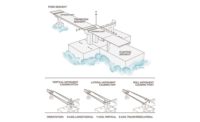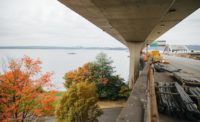ENR's 2017 Top 25 Newsmakers
Found Solution for Using Fixed Rail on Floating Bridges

Transitioning rail to a floating bridge that is constantly bobbing and swaying at the whims of the water required a first-ever solution for Sound Transit. Linking Seattle to points east across Lake Washington, the nearly one-mile-long Interstate 90 floating bridge—one of the world’s longest—was earmarked to receive light-rail service to connect Seattle and Bellevue. But settling on a finished solution wasn’t simple.
The issue centered on how Sound Transit could install rails on a bridge that uses accordion joints to transition from a fixed structure to a floating structure that, due to water levels, rises and lowers as much as 2 ft.
The three-year, $53-million design process solved the issue with insight from British consulting engineer Andy Foan, then used a University of Washington study and extensive on-ground testing in Pueblo, Colo., to ensure that Foan’s solution of a curved transition element actually worked.
 Andy Foan
Andy Foan
Nottingham, England
ENR 12/11/17 p. 14
Engineered an elegant, curved platform system that enables fixed rail to transition to a floating bridge structure. The system can move as much as 2 ft in any direction.
Foan’s creation features 43-ft-long curved platforms that sit on double-pendulum bearings, allowing the rail to act like a continuously variable-radius track panel. Atop the bearings, a curved wing element connects to a hinge that allows the rail to stay on plane, even as the lake tilts the bridge or moves it horizontally or vertically. Movement pushes on the hinge, and the bearings self-level the rail for continuous alignment.
“Quite honestly, when he laid out the winged concept, everyone’s jaws dropped,” says John Sleavin, Sound Transit executive technical adviser and one of the lead engineers on the project. “There was a little bit of a feeling of ‘we are not worthy.’ It was so simple and so obvious, and when everyone saw it, they got it. It became very obvious that it would work. Andy had this great concept, and it took a team to look at every stress and strain. It was a lot of fun.”
Foan says his role was simply to help the design team “assimilate the concept and to participate in whatever way added value.”
Sleavin says, “It was a great opportunity to find the problems and solutions without just looking at how it was done before. You had to think out of the box and go back to engineering principles to find the issues.”
With construction ready on I-90 and the future of rail set for the world’s longest floating bridge—Seattle’s state Route 520 bridge on Lake Washington—Foan says he hopes the “unique” design solution offers a new solution for floating dockyards and tracks in glacial or seismic areas.




